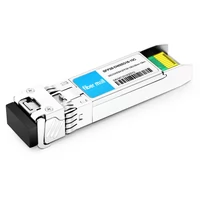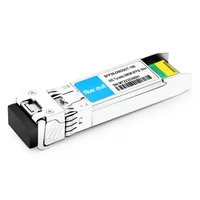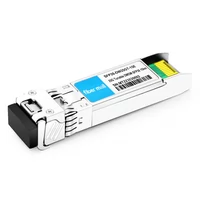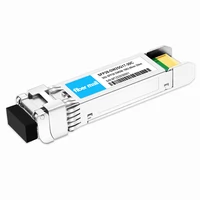The demand for fast and reliable connections in data communication is becoming increasingly important. To be precise, 25G SFP28 DWDM optical transceiver modules are necessary because they allow faster and longer transmission of information over a wide range, thus making them indispensable in the current network infrastructures. This blog post will discuss technical specifications, their operational principles, and their benefits. Furthermore, we shall look at practical applications where they can be used, compatibility considerations when using these devices together, and some implementation tips that best work towards enhancing network performance while increasing capacity. This way, any person who reads through till the end will have learned everything there is to know about selecting and deploying such components successfully into his/her system setup.
Table of Contents
ToggleWhat is a 25G SFP28 DWDM Transceiver?
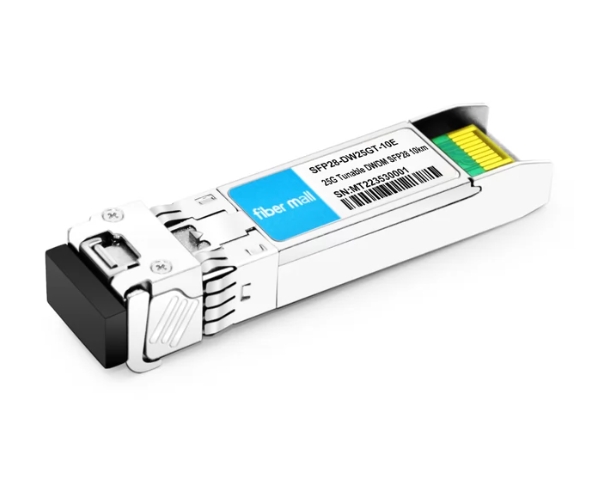
What are the primary uses of a 25G DWDM transceiver?
A 25G DWDM transceiver is mainly used to transfer large amounts of information in data centers, telecom networks and enterprise environments. It allows several wavelengths to be aggregated on one optical fiber thus substantially enhancing the capacity without additional cabling needed. These are widely employed for long-haul and metro Ethernet services, interconnecting data centers as well as offering scalable options for 5G infrastructure. Additionally, they help make better use of current fibers so that service providers can cater to increased bandwidth requirements while maximizing their resource utilization, too.
How does a 25G SFP28 optical transceiver function?
The 25G SFP28 optical transceiver changes electrical signals to optical signals and vice versa to send data through fiber optic cables. The device uses a laser diode to produce light at an appropriate wavelength, which is commonly around 1310 nm or 1550 nm and then modulates it with digital information. After being transferred over the optical fiber, this light goes to the receiving side where it gets transformed back into electric form by means of a photodetector. Such a two-way process supports speeds up to 25 Gbps, ensuring high-speed connection over long distances while keeping signal quality intact. Moreover, thanks to Dense Wavelength Division Multiplexing (DWDM), multiple signals can be transmitted simultaneously using different frequencies, making better use of available bandwidth and greatly improving overall network capacity.
What are the key features of a 25G SFP28 DWDM module?
Many essential qualities of a 25G SFP28 DWDM module make it adaptable and efficient in high-capacity networks. To begin with, it can support high data rates up to 25 Gbps so that data can travel fast over long distances. Secondly, this module employs Dense Wavelength Division Multiplexing (DWDM) technology, which enables many channels to transmit simultaneously through one optical fiber, hence maximizing the utilization of fibers and increasing overall network throughput. Furthermore, these modules are used within specific wavelength bands, usually from 1264.5 nm to 1337.5 nm, making them compatible with existing DWDM infrastructure. In addition to this, they also possess low power consumption characteristics that save energy in data centers. Finally, an ordinary SFP28 DWDM module comes with advanced digital diagnostic capabilities that enable real-time temperature monitoring, among other performance metrics such as voltage or even optical power levels, thus aiding proactive network management.
How to Choose the Right 25G SFP28 DWDM Module?
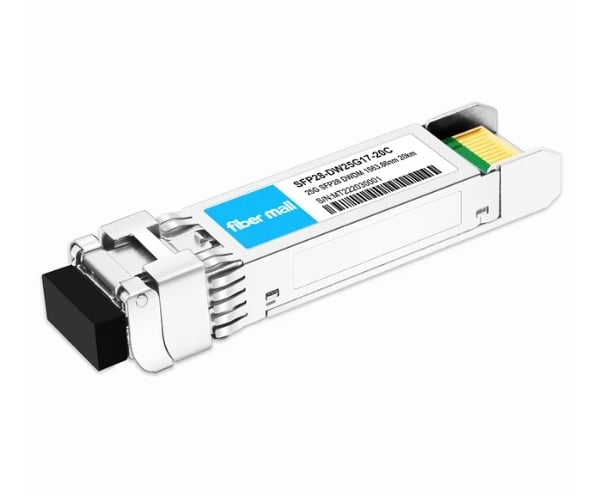
What factors should I consider when selecting a 25G DWDM transceiver?
Several factors should be taken into account when choosing a 25 G DWDM transceiver to ensure the best performance and compatibility with your network infrastructure.
- Compatibility of Wavelength: You must check whether the transceiver works in the correct wavelength range for your current DWDM system. Modules are designed for different wavelength bands, which may affect their compatibility and performance.
- Distance Requirement: Determine how far data has to be transmitted. Different transceivers have varying maximum reach capabilities, so it is important to select the most appropriate module capable of efficiently meeting specific distance requirements.
- Power Consumption: Energy efficiency is a major concern, especially in data centers; thus, low-power transceivers should be considered not only for cost-saving benefits over time but also for environmentally friendly practices.
- Digital Diagnostics: Identify modules that support Digital Optical Monitoring (DOM) features, which enable monitoring parameters such as temperature, voltage, and optical power, among others, in real time. This helps a lot in managing networks effectively and troubleshooting them when necessary.
- Brand & Quality Assurance: Look for manufacturers with a good reputation for quality assurance measures taken during the production process. This will guarantee that the device meets industry standards since reputable brands always subject their products to rigorous tests to ascertain their reliability and performance levels.
Evaluating these points will enable you to select a 25G DWDM transceiver that optimizes efficiency within your network while ensuring seamless integration with other parts of your infrastructure.
How does the wavelength and data rate affect the choice?
Performance and compatibility of optical transceivers in Dense Wavelength Division Multiplexing (DWDM) systems are primarily affected by the wavelength and data rate chosen. First, various wavelengths may be used optimally depending on the transmission distance and dispersion properties of an optical fiber. For example, longer waves like 1550nm are preferred for their low attenuation and good modal dispersion characteristics in long-haul transmissions. Conversely, the data rate determines how much information can be sent during a given period of time. Higher data rates such as 25G and beyond need transceivers to handle wider bandwidths effectively without compromising signal quality.
Further, it is imperative to ensure that the optical transceiver’s wavelength matches multiplexed signals in a DWDM system failure, which could cause cross-talk to occur, affecting signal integrity. Henceforth, having these parameters in mind enables one to make wise choices towards enhancing performance across the entire network; hence, reliability of data transmission throughout infrastructure is achieved.
Which compatible SFP28 transceivers should you consider?
Many reputable models can be picked for a 25G DWDM system for compatible SFP28 transceivers in terms of performance, compatibility, and reliability. To begin with, the Cisco SFP28-25G-SR-S transceiver has gained popularity because it can work on short distances, which may go up to 300 meters over OM4 multimode fiber. The Arista SFP28-25G-LR is an option designed for long transmissions. It can reach up to 10 kilometers through single-mode fiber, thus making it suitable for use in data centers or enterprise networks. Ultimately, the Finisar FTLF1328P3BNL is known for being compatible with different brands of network equipment while supporting both 25G and 10G configurations, making it flexible even during deployment scenarios. Network administrators can achieve the best possible performance with these options while integrating seamlessly into an existing infrastructure.
Installation and Configuration of 25G SFP28 DWDM Modules
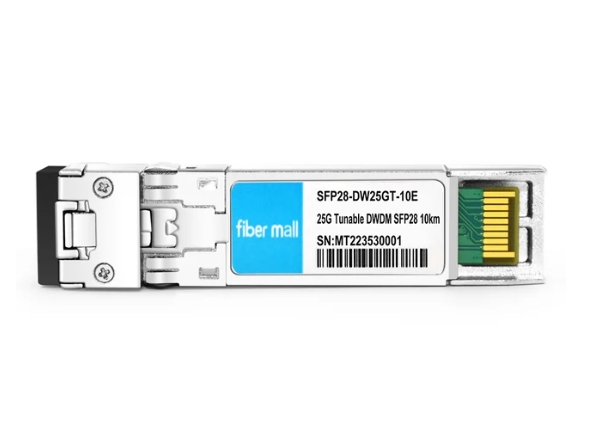
What are the steps to install a 25G SFP28 module?
- To prepare: Gather all the necessary tools, including anti-static bracelets, a clean work surface, and a transceiver module. Also, remember to switch off the device’s power to avoid any electrical issues during installation.
- Uninstall Old Module: Release the locking mechanism softly and pull gently from its slot, provided that an SFP28 or other transceiver module has been installed beforehand.
- Cleaning Ports: Use either a lint-free cloth or an optical cleaning kit on both connectors of a module and the corresponding ports on the switch or router so that no dust particles are left behind, which could degrade optical signal quality.
- Introduce SFP28 Modules: Position a module correctly into slots until there is a clicking sound made by locking clips when they snap back together firmly; this action ensures that pins within connectors line up properly, thereby establishing a good connection between the host device and inserted module.
- Connecting Fiber Cables: Connect suitable optic fiber cables to transceivers, ensuring that every connector is tightly coupled and fastened.
- Charge the Device: Reestablish electricity to the switch or router so that it can see the new SFP28 module.
- Confirm Placement: Check if this new item is acknowledged by management and functioning properly by logging into it after powering up. Verify connection status and guarantee that necessary configuration settings for the specific network environment are applied.
- Evaluate Connection: Last but not least, tests will be performed to prove whether a module works well and check whether data transmission meets the required standards.
By following these instructions, you will install 25G SFP28 modules correctly, which will support better network performance and reliability.
How to configure a 25G DWDM transceiver module for optimal performance?
To optimize the performance of a 25G Dense Wavelength Division Multiplexing (DWDM) transceiver module, follow these steps:
- Specify network requirements: Determine your network’s specific needs, including bandwidth requirements and distance limitations. Only those DWDM channels that best suit your operation will be chosen.
- Introduce compatible hardware: Ensure compatibility between DWDM transceivers, switches, or routers and the optical infrastructures to which they are connected; that is, check if the correct optics and wavelengths have been used.
- Get access to the device configuration interface: Use a web browser or command-line interface to log in through the management IP address of a particular networking device.
- Set Wavelength: According to your network plan, configure the wavelength for the transceiver module. This may involve specifying channel numbers within the management interface or CLI commands.
- Fine-tune power settings: Adjust optical transmit power settings properly to match the loss budget of the fiber link being worked on. This helps maintain signal integrity over long distances.
- Enable Forward Error Correction (FEC): Switch on FEC if supported by the transceiver because it enhances error correction capability, thereby increasing reliability during the data transmission process.
- Performance metrics monitoring: Continuously keep track signal-to-noise ratio (SNR), bit error rate (BER) among other performance parameters via management interface so as to ensure everything runs smoothly.
- Conduct periodic tests: Perform regular checks on performance, which enable the identification of degradations over time and allow for early maintenance before such problems impact overall network functioning.
If we go through each step by step without skipping any single instruction mentioned above, then we will definitely be able to make robust and efficient networks using 25Gbps DWDM modules.
What cables and connectors are used with 25G SFP28 modules?
The 25G SFP28 modules have been designed so that they can work with different types of cables and connectors, which ensures flexibility and compatibility in high-speed networks. Below are the most commonly used cables:
- Direct Attach Copper (DAC) Cables: These passive copper cables are popular because they are cheap and simple to use over short distances. They normally have SFP28 connectors, making them suitable for data centers that can extend up to 5 meters long.
- Single-Mode Fiber (SMF): Single-mode fiber optic cables with LC connector ends are preferred when dealing with longer distances. Depending on the specific SFP28 module and optical specifications, this type can go up to 10 kilometers or more.
- Multi-Mode Fiber (MMF): For connections within a data center, multi-mode fibers may be used alongside SFP28 modules. Often OM4 or OM5 fiber types are employed where such a cable can reach up to 300 meters while using LC connectors.
Ultimately, what kind of cable you choose depends on your network needs, such as bandwidth requirements and distance coverage. Failure to select correctly may lead to poor performance or even incompatibility in high-speed data transmission applications.
Testing and Troubleshooting 25G SFP28 DWDM Transceivers
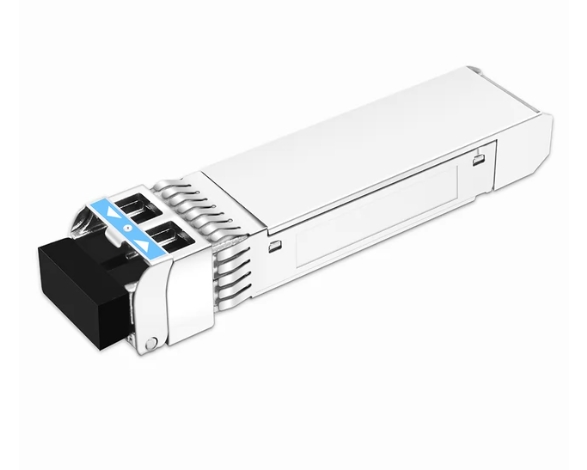
What are the common issues with 25G DWDM transceivers?
Several common issues could arise while deploying 25G Dense Wavelength Division Multiplexing (DWDM) transceivers and affect network performance and reliability.
- Compatibility Issues: Among the main concerns is compatibility between the transceiver and network equipment. Connectivity problems or reduced performance may be caused by mismatched optical specifications like wavelength or signal standards.
- Signal Integrity: DWDM transceivers can easily suffer from signal degradation due to factors such as optical loss, dispersion as well as polarization mismatch. These challenges might lead to higher bit error rates (BER) thus requiring careful designing and monitoring of optical networks.
- Temperature Sensitivity: Fluctuations in temperatures affect DWDM transceivers. Performance deterioration or failure may occur when they operate beyond specified temperature ranges. Appropriate environmental controls within the data center infrastructure where these transceivers are deployed should be ensured.
- Installation and Configuration Errors: Incorrect installation or configuration can cause many problems, including wrong BIOS settings or firmware versions that do not support the latest protocols. Such risks can be mitigated through rigorous testing during the installation process coupled with religiously following verification procedures.
These usual suspects bring three things to light: thoroughness in checking for compatibility, testing hardiness, and maintaining the best environmental conditions so as to guarantee that a 25G DWDM transceiver works reliably on a network system.
How to test the performance of a 25G SFP28 DWDM module?
To test the performance of a 25G SFP28 DWDM (Dense Wavelength Division Multiplexing) module, it is necessary to undertake a number of steps:
- Measurement of optical power: The transceiver’s output power must be measured using an optical power meter. For proper functionality validation, these values must be within the manufacturer’s specified range.
- Bit Error Rate (BER) Testing: To evaluate error rates during data transmission, use either test sets or network analyzers for BER tests. A low error rate means high performance and signal integrity while high ones may indicate signal degradation problems or bad connection issues.
- Assessment of Transmission Distance and Loss: It is important to know what maximum distance can be achieved while maintaining an acceptable quality level. This can be done by transmitting signals over different lengths of fiber to measure the impact on optical loss and see if they meet DWDM system requirements.
- Temperature Test: Monitor how well this module works when subjected to various temperature conditions within its rated operating range, including verifying thermal cycle functionality tests.
- Protocol Compliance Verification: Ensure that this module complies with relevant IEEE standards for 25G Ethernet compliance. Transceivers should be tested using protocol analyzers which confirm correct operation with different network protocols.
These methods help ensure reliability and performance capabilities, such as those used in optical network systems employing 25GHz small form factor pluggable modules based on dense wavelength division multiplexing technology.
What tools are needed for diagnosing 25G transceiver issues?
The required tools for successful 25G transceiver troubleshooting are as follows:
- Optical Power Meter: An optical power meter measures the output power of a transceiver and checks whether it falls within the range given by its manufacturer. These meters also detect signal loss, which may impact performance.
- Bit Error Rate Tester (BERT): A BERT assesses error rates during data transmission, indicating the health of signals while pointing out areas along the transmission path that need attention.
- Network Analyzer: This equipment comprehensively tests signal quality and evaluates different network conditions where a transceiver may perform. It ensures compliance with industry standards and helps in diagnosing protocol compliance issues.
- Protocol Analyzer: Used together with network analyzers, they confirm that transceivers work well with various network protocols besides verifying correct frame integrity and timing.
- Temperature Chamber: Temperature chambers are used to evaluate how well a transceiver operates under different thermal environments. This guarantees reliable operation within these devices’ specified temperature ranges.
By following this guide, one can accurately identify problems with 25Gbps optical modules, thus enabling better performance of such systems across networks.
Application and Performance Considerations for 25G SFP28 DWDM
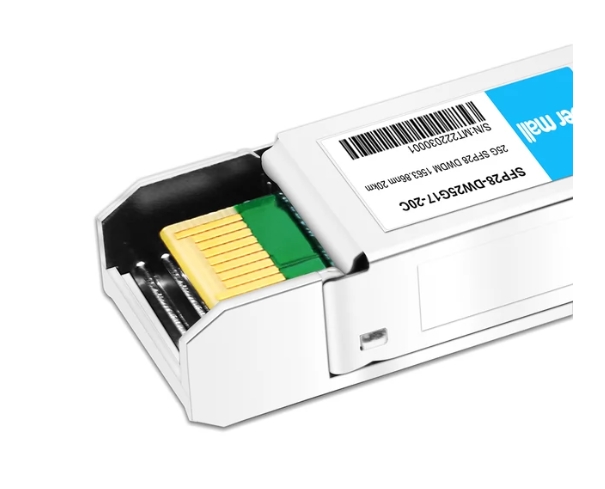
Where are 25G SFP28 DWDM modules commonly deployed?
In data centers, metropolitan area networks (MANs), and long-distance telecommunication systems, 25G SFP28 DWDM (Dense Wavelength Division Multiplexing) modules are extensively used. These modules allow numerous data streams to be transmitted over one fiber optic cable, thus enabling high-capacity interconnections between network devices. They also find increasing applications in cloud computing environments that heavily rely on scalable bandwidth as well as enterprise network backbones demanding strong performance over medium distances. Moreover, they are indispensable for supporting video streaming, real-time data analytics, or large-scale cloud services requiring both high throughput and low latency.
How do 25G transceivers perform in data centers?
To boost data center performance, 25G transceivers were created to provide a larger bandwidth and enable faster transmission of information through network designs. They are especially useful in compact spaces because they make it possible for more bits to be transferred per rack unit, which also optimizes space utilization. Lowering latency while speeding up packet processing, these devices seamlessly connect networking tools and thus support vital applications such as virtualization, cloud services, or big data processing. Additionally, they can work with the already existing 10G infrastructure, which makes them cost-effective when upgrading data centers without necessarily changing everything about their systems so as to enhance operational efficiency levels within an organization. Finally, this means that these little things have become very important if we want our machines to work faster than ever!
What are the benefits of using 25G DWDM in 100GHZ C-band networks?
100GHz C-band networks, which are 25G Dense Wavelength Division Multiplexing (DWDM), have significant advantages such as increased capacity and spectral efficiency. DWDM technology allows optical fiber to transmit many data channels at once, thus maximizing the usage of the available bandwidth. This makes it easy to scale up his or her data requirements accordingly; hence, integrating high-volume applications, including video conferencing and cloud services, becomes seamless.
Additionally, signal quality and reach are improved by using 25G DWDM, reducing the number of intermediate repeaters needed and consequently lowering total infrastructure costs. Besides this fact, it also supports sophisticated network management and monitoring capabilities that provide instant insights into network performance and reliability, thus enabling operators to achieve more efficient operations with lower downtimes while tactically positioned toward meeting various digital transformation scenarios. In general terms, what does all these mean? It implies that through 100GHz C-band networks, which are based on 25G DWDM, telecommunications companies can offer stronger, better services to their customers.
Reference Sources
Frequently Asked Questions (FAQs)
Q: What is a 25G DWDM SFP28 Optical Transceiver Module?
A: The 25G DWDM SFP28 transceiver module is optical and designed to be plugged into a device. It’s rated for 25 gigabits per second on Ethernet applications and supports single-mode fiber optic interconnects and 25Gbase-dwdm systems that transmit through DWDM wavelengths.
Q: What is the maximum transmission distance for a 25G DWDM SFP28 module?
A: The farthest a signal can travel between two points using this equipment typically extends ten kilometers over one strand of single-mode fiber (SMF).
Q: What type of fiber and connector does the 25G DWDM SFP28 module use?
A: These modules use single-mode fiber (SMF) and duplex LC connectors to provide optimum optics performance.
Q: Are 25G DWDM SFP28 modules compliant with any standards?
A: Numerous standards were explicitly created for use with this product. Some examples include but are not limited to RoHS compliance, ITU-T G.698.2, SFF-8402, and SFF-8472.
Q: Do 25G DWDM SFP28 modules support tunable wavelengths?
A: Occasionally, users may require different wavelengths depending on what they are connecting – tunable variants allow individuals greater flexibility within these scenarios.
Q: Can CPRI and Ethernet applications use the 25G DWDM SFP28 modules?
A: CPRI and Ethernet applications can use the 25g dwdm sfp28 modules interchangeably because they are designed for use with multiple systems within data centers or telecommunication environments.
Q: How do I know if my transceivers are compatible with and of good quality for 25G DWDM SFP28?
A: You can verify your transceivers’ highest quality and compatibility by buying them from good vendors such as FS.com or Smartoptics. Additionally, check if they meet MSA standards before connecting with other devices on the network.
Q: What kind of monitoring features does a 25G DWDM SFP28 module support?
A: They have digital diagnostics monitoring (DDM) functions that help to observe temperature, voltage, and optical power parameters in real-time.
Q: Are there any testing programs specific to these modules?
A: Yes, established testing programs are paramount to guaranteeing reliability and performance; therefore, vendors should perform comprehensive tests that may involve advanced levels of electrical evaluations alongside optical ones.
Q: Can I use 10G networks for 25G DWDM SFP28 transceivers?
A: No, you cannot since their design is explicitly meant for transmission at higher data rates, i.e., 25 Gbps ethernet, unlike those used in backward compatibility with 10g network speed due to different signal structures.
Related Products:
-
 SFP28-DW25G18-10C 25G DWDM SFP28 C18 100GHz 1563.05nm 10km LC SMF DDM Transceiver Module
$265.00
SFP28-DW25G18-10C 25G DWDM SFP28 C18 100GHz 1563.05nm 10km LC SMF DDM Transceiver Module
$265.00
-
 SFP28-DW25GT-10E 25G Tunable DWDM SFP28 C-band 48 channels 10km Optical Transceiver Module
$500.00
SFP28-DW25GT-10E 25G Tunable DWDM SFP28 C-band 48 channels 10km Optical Transceiver Module
$500.00
-
 SFP28-DW25GT-15E 25G Tunable DWDM SFP28 C-band 48 channels 15km Optical Transceiver Module
$550.00
SFP28-DW25GT-15E 25G Tunable DWDM SFP28 C-band 48 channels 15km Optical Transceiver Module
$550.00
-
 SFP28-DW25G17-20C 25G SFP28 DWDM C17 100GHz 20KM 1563.86nm LC SMF DDM Transceiver Module
$600.00
SFP28-DW25G17-20C 25G SFP28 DWDM C17 100GHz 20KM 1563.86nm LC SMF DDM Transceiver Module
$600.00

